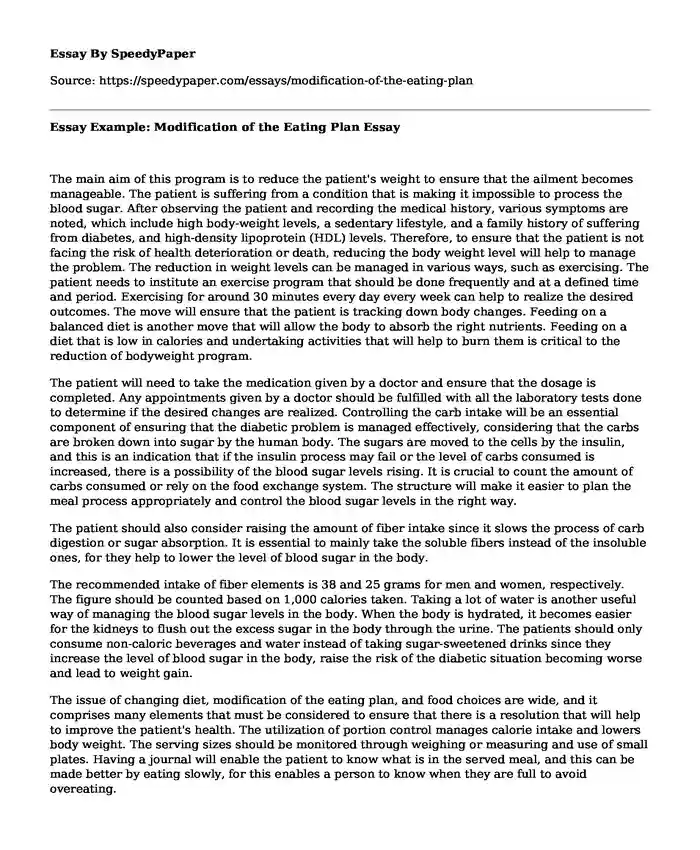
| Type of paper: | Course work |
| Categories: | Healthcare Diet Nutrition |
| Pages: | 3 |
| Wordcount: | 800 words |
The main aim of this program is to reduce the patient's weight to ensure that the ailment becomes manageable. The patient is suffering from a condition that is making it impossible to process the blood sugar. After observing the patient and recording the medical history, various symptoms are noted, which include high body-weight levels, a sedentary lifestyle, and a family history of suffering from diabetes, and high-density lipoprotein (HDL) levels. Therefore, to ensure that the patient is not facing the risk of health deterioration or death, reducing the body weight level will help to manage the problem. The reduction in weight levels can be managed in various ways, such as exercising. The patient needs to institute an exercise program that should be done frequently and at a defined time and period. Exercising for around 30 minutes every day every week can help to realize the desired outcomes. The move will ensure that the patient is tracking down body changes. Feeding on a balanced diet is another move that will allow the body to absorb the right nutrients. Feeding on a diet that is low in calories and undertaking activities that will help to burn them is critical to the reduction of bodyweight program.
The patient will need to take the medication given by a doctor and ensure that the dosage is completed. Any appointments given by a doctor should be fulfilled with all the laboratory tests done to determine if the desired changes are realized. Controlling the carb intake will be an essential component of ensuring that the diabetic problem is managed effectively, considering that the carbs are broken down into sugar by the human body. The sugars are moved to the cells by the insulin, and this is an indication that if the insulin process may fail or the level of carbs consumed is increased, there is a possibility of the blood sugar levels rising. It is crucial to count the amount of carbs consumed or rely on the food exchange system. The structure will make it easier to plan the meal process appropriately and control the blood sugar levels in the right way.
The patient should also consider raising the amount of fiber intake since it slows the process of carb digestion or sugar absorption. It is essential to mainly take the soluble fibers instead of the insoluble ones, for they help to lower the level of blood sugar in the body.
The recommended intake of fiber elements is 38 and 25 grams for men and women, respectively. The figure should be counted based on 1,000 calories taken. Taking a lot of water is another useful way of managing the blood sugar levels in the body. When the body is hydrated, it becomes easier for the kidneys to flush out the excess sugar in the body through the urine. The patients should only consume non-caloric beverages and water instead of taking sugar-sweetened drinks since they increase the level of blood sugar in the body, raise the risk of the diabetic situation becoming worse and lead to weight gain.
The issue of changing diet, modification of the eating plan, and food choices are wide, and it comprises many elements that must be considered to ensure that there is a resolution that will help to improve the patient's health. The utilization of portion control manages calorie intake and lowers body weight. The serving sizes should be monitored through weighing or measuring and use of small plates. Having a journal will enable the patient to know what is in the served meal, and this can be made better by eating slowly, for this enables a person to know when they are full to avoid overeating.
Actions to Take for this Patient
The patient should consider changing the diet, having control over what is being eaten, and exercising frequently.
Calculated BMI: 26.81Wt in Kg /Ht in m2 =80/ (1.7272) ^2 m
=80/ 2.9832
=26.81
Peters's height is given as 172.72 centimeters, and their weight is 80kg. Therefore, after computation, the BMI is determined as 26.81
The recommended BMI level is 18.5 to 24.9, and this means that anything above or below these figures is not good for the human body. The calculated BMI level is 26.81, which is above a healthy one, and this means that the patient is obese and should follow recommended practices, such as exercising, lowering food consumption levels, and eating a healthy diet. The patient should reduce the body weight to around 70 kg to be within the right BMI level. Therefore, by losing an average of 1 kg per day, more than ten days will be needed to realize the outcome of 70 kg. Even after hitting the 70kg level, the patient should continue to exercise and ensure that there is no weight gained. Therefore, the recommended intake of carbohydrates (CHO), proteins, and lipids should be 800 to 890 Cals, 200-280 Cals, and 430 Cals, respectively.
Cite this page
Essay Example: Modification of the Eating Plan. (2023, May 18). Retrieved from https://speedypaper.net/essays/modification-of-the-eating-plan
Request Removal
If you are the original author of this essay and no longer wish to have it published on the SpeedyPaper website, please click below to request its removal:
- Man Flu Essay Sample
- Free Essay with a Speech Sample Dedicated to Diabetes
- Free Essay on Communicable Diseases in Public Health
- Essay Sample on Psychoeducation for Early Intervention
- Essay Sample on Ethical Dilemmas Encountered in the Nursing Practice
- Essay Sample on Cruzan v. Director, Missouri Department of Health, 497 U.S. 261 (1990)
- Essay Sample on Therapeutic Group Works
Popular categories




